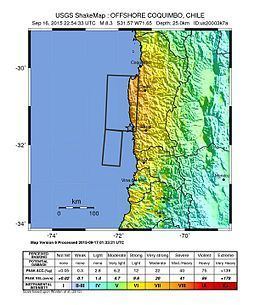Magnitude 8.3 Mw Areas affected ChileArgentina Tsunami Yes | Depth 22.4 km (USGS) Max. intensity VIII (Severe) Date 16 September 2015 | |
 | ||
Similar 2010 Chile earthquake, 2014 Iquique earthquake, 1960 Valdivia earthquake, 1647 Santiago earthquake, 1906 Valparaíso earthquake | ||
The 2015 Illapel earthquake occurred 46 km (29 mi) offshore from Illapel, Chile on September 16 at 19:54:33 Chile Standard Time (22:54:33 UTC), with a moment magnitude of 8.3. The initial quake lasted three minutes, and was followed by several aftershocks greater than magnitude six. The Chilean government reported 13 deaths and 6 missing.
Contents
Earthquake
The earthquake occurred on thrust faults along the boundary of the Nazca and South American plates. The region frequently produces large earthquakes, and 15 others of magnitude 7 or higher have taken place within 400 km of the epicenter over the past 100 years.
Damage and range
Illapel, an inland city of some 30,000 residents, was reported immediately to be without electricity or drinking water. The panic took over the great cities like La Serena , Valparaiso and the capital Santiago. Two days after the quake, about 90,000 people were still without electricity. On September 21, officials were reporting over 9,000 people had been left homeless by the quake.
Tall buildings swayed and car alarms were set off in Buenos Aires, 1,110 kilometres (690 mi) away, and the earthquake was felt in São Paulo, more than 2,600 kilometres (1,600 mi) away. The Argentine provinces of Mendoza, San Juan, Córdoba, Tucumán, La Rioja, San Luis and Santa Fe were also affected.
Tsunami
Tsunami watches, warnings, and advisories were issued in Ecuador, Peru, New Zealand, Fiji, Solomon Islands, Hawaii, California and Japan. The first tsunami waves arrived on the Chilean coast within minutes. A wave 4.5 m (15 ft) high was observed along the coast of Coquimbo and the cities of Coquimbo, Tongoy and Concón nearby to Valparaiso reported flooding; large fishing vessels were swept into the streets of Coquimbo, which reported heavy damage.
In Tongoy, large areas along the sea front were destroyed. Across the region at least 500 buildings were destroyed, while dozens of beachfront homes in Los Vilos were damaged or destroyed. A state of emergency was declared in Coquimbo a day after the tsunami, with troops to be deployed to the area.
Evacuations
Chilean authorities ordered the immediate evacuation of the coast due to tsunami risk, with many people in coastal areas receiving automatic notices by cellphone shortly after the quake. The undersecretary for the ministry of the interior and public security reported that the evacuation affected one million people across the country.
Although causing damage in the hundreds of millions, the Illapel earthquake's low death toll relative to the 525 casualties of the significantly more powerful 2010 Chile earthquake was credited, in part, to its localization in a less-populated region, better coastal preparedness and an improved tsunami warning system, the longstanding enforcement of seismic building codes, and an improved emergency response.
